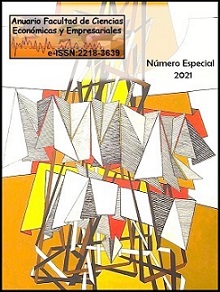Social dimension of food self-sufficiency in the Contramaestre municipality, Santiago de Cuba
Keywords:
food self-sufficiency, social dimension, health, education, habitatAbstract
The objective of the article is to analyze the social dimension of food self-sufficiency in the Contramaestre municipality of Santiago de Cuba in the 2014-2019 period using descriptive statistics and economic analysis. The indicators were selected that by areas of intervention allowed to carry out the analysis, with the interpretation of their behavior and identification of deficiencies. The analysis showed that the limitations of the municipality are expressed in the following indicators: the health area, the decrease in the birth rate, the increase in the mortality rate, the high rate of low birth weight and the high mortality rate maternal; in the area of education, the decrease in the number of graduates at all levels of education; in the habitat area, the limited number of finished homes, the decrease in the percentage of the population with access to drinking water and the limited percentage of inhabitants with sewerage.
References
Banco Mundial. (2018). Proyecto de capital humano. https://www.worlbank.org. CEPAL, N. (1992). Equidad y transformación productiva: un enfoque integrado. Cepal.
CIEM; PNUD Cuba, (2019). Informe nacional de desarrollo humano. Ascenso a la raíz. La perspectiva local del DH en Cuba. http://www.cuba.un.org
Comisión Económica para América Latina y el Caribe (Cepal). (2015). Agenda 2030 y los Objetivos de Desarrollo Sostenible. https: //www.cepal.org
Cuba. (2019). Constitución de la República de Cuba. http://www.parlamentocubano.gob.cu/index.php/en-pdf-nueva-constitucion-dela-republica-de-cuba/.
Cuba. (2019). Plan Nacional de Desarrollo Económico y Social 2030 de Cuba. http://www.mep.gob.cu
Cuba. (2020). Plan Nacional de Seguridad Alimentaria y Educación Nutricional de Cuba. http://www.fao.org
FAO, (1996). Declaración de Roma sobre la seguridad alimentaria mundial y plan de acción de la cumbre mundial de alimentación. https://www.fao.org./wfs/final/rd-s.htm
FAO, (2002). Informe de la Cumbre Mundial sobre la Alimentación: Cinco años después. http://www.fao.org/3/a-y7106s.pdf
FAO, (2020). Seguridad Alimentaria bajo la Pandemia de COVID-19. Informe preparado por FAO a solicitud de la Coordinación Nacional de la Presidencia ProTémpore de México ante la CELAC. htpp://www.fao.org
FAO. (2019). La situación de la seguridad alimentaria y la nutrición en el mundo. htpp://www.fao.org
Instituto de Planificación Física (IPF) Santiago de Cuba, (2020). Plan General de Ordenamiento Territorial y Urbano de Contramaestre. Fondos del IPF.
Martínez, M. (2021). El problema no es que envejece la población, sino que decrece. Periódico Granma, 26/agosto. htpp://www.granma.cu
Marx, K. (1980). El Capital. (T-III). La Habana: Editorial Ciencias Sociales.
ONEI. (2014-2020). Anuarios Estadísticos de la provincia de Santiago de Cuba. http://www.onei.gob.cu.
ONEI. (2014-2020). Anuarios Estadísticos del municipio de Contramaestre. http://www.onei.gob.cu.
Partido Comunista de Cuba. (PCC). (2016). Lineamientos de la Política Económica y Social del Partido y la Revolución. VII Congreso del PCC. Cuba. La Habana: Editora Política.
PNUMA. (1990). Desarrollo humano. Informe 1990. http://www.hdr.undp.org
PNUMA. (2020). Informe de desarrollo humano. La próxima frontera. http://www.hdr.undp.org
Published
Issue
Section
License
Copyright (c) 2021 Elena María Stewart-Santos, Milagros Morales-Pérez, Rosa Marina Castellanos-Dorado

This work is licensed under a Creative Commons Attribution-NonCommercial-NoDerivatives 4.0 International License.
Esta revista proporciona un acceso abierto inmediato a su contenido, basado en el principio de que ofrecer al público un acceso libre a las investigaciones ayuda a un mayor intercambio global de conocimiento.
This journal provides immediate open access to its content, based on the principle that providing the public with free access to research supports a greater global exchange of knowledge.



























 Universidad de Oriente
Universidad de Oriente 